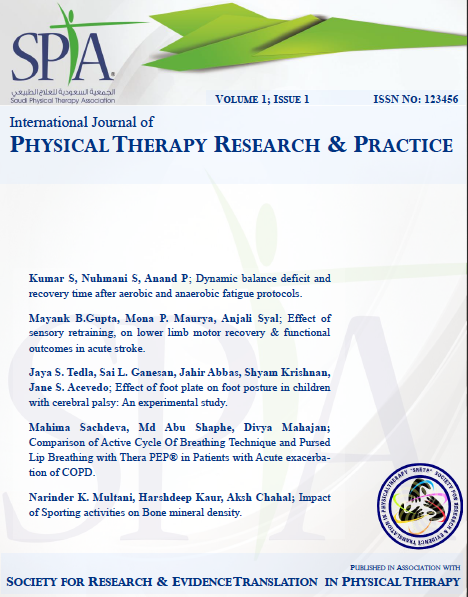Comparison Of Kaltenborn Mobilization With Muscle Energy Technique In Patients With Adhesive Capsulitis: A Randomized Clinical Trial
DOI:
https://doi.org/10.62464/ijoprp.v4i4.103Keywords:
Adhesive capsulitis, Kaltenborn, Muscle Energy TechniquesAbstract
Background: Adhesive capsulitis is one of the disabling conditions that significantly affects individuals of all ages. Manual therapy is one of the most effective approaches to treat this condition.
Objective: This study aims to compare the effectiveness of Kaltenborn mobilization and Muscle energy techniques on pain, disability, and Range of motion in patients with Adhesive Capsulitis.
Methods: This was a parallel arm single-blinded randomized clinical trial. Seventy-six patients with adhesive capsulitis were randomly assigned into two groups through computer software. The outcome measures included pain measured through the Numeric Pain Rating Scale (NPRS), shoulder range of motion measured by a Goniometer, and disability measured by the Shoulder Pain and Disability Index (SPADI). The measurements were taken at baseline and in the 4th week after the intervention. The analysis was done through paired t-test using SPSS version 26.
Results: The results of this randomized clinical trial exhibited that Kaltenborne mobilization resulted in a significant difference in pain, shoulder range of motion, and functional mobility in patients with adhesive capsulitis (p-value <0.05). The within-group comparison showed improvement in both groups however between-group comparison showed greater improvement in the Kaltenborn group.
Conclusion: This study concluded that Kaltenborn mobilization was more effective in reducing pain, disabilities, and increasing range of motion along with functional mobility in patients with adhesive capsulitis.
References
Afzal, F. (2022). Effectiveness of Kaltenborn Joint Mobilization Technique Versus Muscle Energy Technique on Pain and Disability in Patients with Shoulder Adhesive Capsulitis. Journal of Clinical and Research News, 6, 134–140.
Alam, M. F., Azharuddin, M., & Zaki, S. (2024). Effectiveness of shoulder mobilization combined with muscle energy technique in the management of adhesive capsulitis: A randomized control trial. Sports Journal of Sports Medicine, 24, 35–42.
Ali, B., Arsh, A., Khalil, A. A., & Zahoor, M. (2018). Prevalence of shoulder pain and adhesive capsulitis in post-mastectomy patients. Journal of Medical Sciences, 26, 194–197.
Ali, M., Hashim, M., Waseem, I., Manzoor, S., & Ahmad, I. (2022). Comparison of Maitland Mobilization and Muscle Energy Technique on Pain, Range of Motion and Functions in Adhesive Capsulitis. Pakistan BioMedical Journal, 129–133.
Breckenridge, J. D., & McAuley, J. H. (2011). Shoulder Pain and Disability Index (SPADI). Journal of Physiotherapy, 57, 197.
D’Orsi, G. M., Via, A. G., Frizziero, A., & Oliva, F. (2012). Treatment of adhesive capsulitis: A review. Muscles, Ligaments and Tendons Journal, 2, 70.
Deshmukh, A., Deo, S., Salgia, A. K., & Agarwal, T. (2013). A rare unusual case presentation of tuberculosis of the shoulder joint. Journal of Orthopaedic Case Reports, 3, 23.
Do Moon, G., Lim, J. Y., Da Yoo, K., & Kim, T. H. (2015). Comparison of Maitland and Kaltenborn mobilization techniques for improving shoulder pain and range of motion in frozen shoulders. Journal of Physical Therapy Science, 27, 1391–1395.
Gill, M. A., Gohel, B. P., & Singal, S. K. (2018). Effect of muscle energy technique on pain and function in adhesive capsulitis—An interventional study. International Journal of Health Sciences and Research, 8, 133–137.
Iqbal, M., Riaz, H., Ghous, M., & Masood, K. (2020). Comparison of Spencer muscle energy technique and passive stretching in adhesive capsulitis: A single-blind randomized control trial. Journal of the Pakistan Medical Association, 70, 2113–2118.
Kadi, R., Milants, A., & Shahabpour, M. (2017). Shoulder anatomy and normal variants. Journal of the Belgian Society of Radiology, 101(Suppl. 1).
Kotagiri, S., Mathur, N., Balakavi, G., & Songa, A. K. (2019). The effectiveness of muscle energy technique and mobilization to improve the shoulder range of motion in frozen shoulder. International Archives of Integrated Medicine, 6(1).
Kwaees, T. A., & Charalambous, C. P. (2014). Surgical and non-surgical treatment of frozen shoulder: Survey on surgeons’ treatment preferences. Muscles, Ligaments and Tendons Journal, 4(4), 420–424.
Lamplot, J. D., Lillegraven, O., & Brophy, R. H. (2018). Outcomes from conservative treatment of shoulder idiopathic adhesive capsulitis and factors associated with developing contralateral disease. Orthopaedic Journal of Sports Medicine, 6(7), 2325967118785169.
Manske, R. C., & Prohaska, D. (2008). Diagnosis and management of adhesive capsulitis. Current Reviews in Musculoskeletal Medicine, 1, 180–189.
Michener, L. A., Snyder, A. R., & Leggin, B. G. (2011). Responsiveness of the numeric pain rating scale in patients with shoulder pain and the effect of surgical status. Journal of Sport Rehabilitation, 20, 115–128.
Pattnaik, S., Kumar, P., Sarkar, B., & Oraon, A. K. (2023). Comparison of Kaltenborn mobilization technique and muscle energy technique on range of motion, pain, and function in subjects with chronic shoulder adhesive capsulitis. Hong Kong Physiotherapy Journal, 43, 149–159.
Rezwan, A., Shahriar, T., Rasal, A., Rahman, M., Haque, T., et al. (2021). Study on effectiveness of Kaltenborn mobilization techniques grade III in patients with frozen stage of adhesive capsulitis of shoulder joint. European Journal of Medical and Health Sciences, 3, 50–53.
Sharma, H., & Patel, S. (2020). Effectiveness of muscle energy technique versus capsular stretching among patients with adhesive capsulitis. International Journal of Research and Review, 7, 2454–2237.
T, G C. (2000). Functional anatomy of the shoulder. Journal of Athletic Training, 35, 248–255.
Umar, M., Anwar, A., Khan, N., Marryam, M., & Rashid, H. (2023). Effectiveness of Kaltenborn mobilization versus muscle energy technique on shoulder range of motion in adhesive capsulitis. Journal of Rehabilitation Medicine and Clinical Communications, 27.
Vijayan, V., & Jayabharathi, S. (2019). A comparative study on effectiveness of muscle energy technique versus Cyriax’s deep friction technique in adhesive capsulitis. Indian Association of Biomedical Scientists Journal, 39, 622–627.
Wang, K., Ho, V., Hunter-Smith, D. J., Beh, P. S., Smith, K. M., et al. (2013). Risk factors in idiopathic adhesive capsulitis: A case control study. Journal of Shoulder and Elbow Surgery, 22, e24–e29.
Willmore, E. G., Millar, N. L., & van der Windt, D. (2022). Post-surgical physiotherapy in frozen shoulder: A review. Shoulder & Elbow, 14, 438–451.

Downloads
Published
Issue
Section
License
Copyright (c) 2025 International Journal of Physical Therapy Research & Practice

This work is licensed under a Creative Commons Attribution-NonCommercial-NoDerivatives 4.0 International License.




